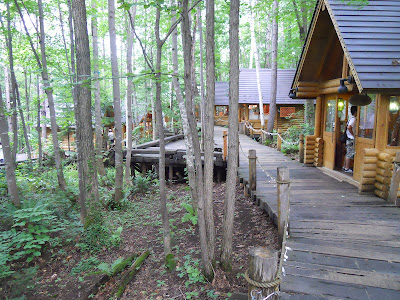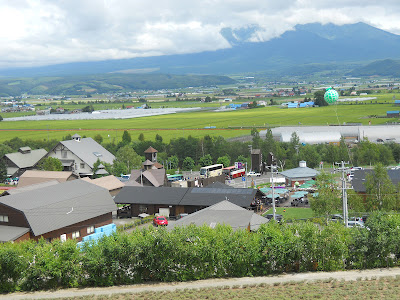Furano. In a valley stretching
through Hokkaido's volcanic and mountainous heart, upon the Ishikari
River, resides this postcard-picture town at the exact geographic
centre of the island.
This is an agrarian region, and
on first impressions presents as idyllic a rural scene as you can
get. Tranquil, clean, hard-working, prosperous: from its origins as a
settlement site of immigrant Japanese homesteaders in the 1890s,
Furano has soared to fame as much as a tourist magnet for its
spectacular flower fields and ski slopes, as it has as an
agricultural engine churning out onions, carrots and melons by the
shipload.
I am unequipped to measure how
sustainable it is, or indeed how sustainable modern life in Hokkaido
is as a whole. But all impressions paint Furano as one of the most
successful endeavours to emerge from the long Japanese colonization
project, and one well suited to its most literal central location.
It is well conscious of that
place: hence its nickname as the “navel” of Hokkaido, and its
Bellybutton Festival every July. But it is central in other ways,
too: it represents precisely the Arcadian image that forms when
Hokkaido is spoken of in places like Tokyo, of lush fields, clean
air, mountains along the horizon, where all the best (and most
expensive) dairy products and vegetables come from; and it seems too
a meeting point between the extremes of human and earth, between the
cities and the wilderness, where the two mingle, sit together, and
work out what their collaboration produces.
Case in point: the Tomita Farm,
famed for its lavender fields and packed to the seams with visitors,
many of them Chinese. As a producer of original lavender products and
a prime tourist destination, this farm may be a consummate example of the
settlers' successes. But if the account it gives of its story is
accurate, this was not always what it expected. On the contrary, like
all who came to Hokkaido to build themselves a better future, these
people had to put their backs into it to earn their happy outcome,
and stay the course even when times grew rough and dreams were
sinking around them.
It started with Tokuma Tomita,
who migrated to Hokkaido in 1903 from his old home of Fukui
prefecture (incidentally the same prefecture as the most recent
nuclear reactor controversy). As we have seen, the economic circumstances for Hokkaido's settlers fell apart
in due course with recession and social unrest, and suffered still
more as the country clambered out of its World War II catastrophe. By
the 1950s, Tokuma's grandson Tadao, in his early 20s, became
disillusioned with agriculture's limited prospects.
One day he walked into one of
Furano's lavender fields. The Furano region's cool, dry climate was
well-suited for growing lavender, where people had begun to pioneer
it. In Tadao's own words:
“The lavender was in full
bloom...the scenery was incredible. I stood transfixed beside that
vast purple sea. Faced with such a sight, I couldn't stop feeling
amazed and awed. The sensation is almost impossible to express in
words.
“So many feelings ran
through my heart, and I could barely keep from fainting with
dizziness...From that date, I started dreaming. I was afire with a
passion to cultivate a wonderful lavender field all by myself.”
It was the fragrance that gave it
its magic. The farm began cultivating lavender for its essence in
1958, and grew on the back of Japan's economic boom in the 1960s,
peaking at 230 hectares of planted lavender in 1970.
In the black-and-white
photographs on display from the era, Tadao Tomita cuts a romantic
figure. As though from the reels of a great agricultural drama on the
trials and hopes of a pioneer and a dreamer, he looks out across the
violet fields with dignity and vision, together with his wife and
labourers as devoted to those visions as he. As a close-knit team,
the images and excerpts follow their blossoming relationship with
their land.
Alas, the market is a soulless
machine, and wreaks cruelty unless we humans are ready to stop it. In
1972, the import of artificial substitutes for lavender fragrance
brought demand crashing down, and companies stopped purchasing their
oils. Lavender farmers went under all over Furano, and the 'purple
seas' receded from the valley. In Tadao's account:
“It was early in the month
of May, and the typically dry wind was blowing during spring
cultivation. I forced myself to get on the tractor and drive into the
field. The lavender crunched beneath the wheels of the tractor. All
the precious branches that I'd taken care of broke off, and the
stumps were destroyed. It sounded like the lavenders were crying.
After a moment, it started to seem as if I were killing my own
daughters. I couldn't go on.
“When I turned back, my wife
was crouching at the edge of the field, crying. She was feeling the
same way as I was.”
In dire financial difficulties,
the Tomita family fell back on rice cultivation to make ends meet,
while their passion for lavender kept them desperately fighting off
the impulse to no longer grow it. Then in 1976, images of those vast
purple fields appeared on the Japan Railways (JR) calender, drawing
tourists to come to see them; and as they struggled on, Tadao began
to explore the ways they might keep producing lavender, and use it to
make new and wonderful things.
Things like potpourri, which the
farm launched in 1983; lavender soap, from 1987; and original Furano
perfume from essential lavender oils, which won first prize at the
Lavender Perfume Fair in France in 1990 and still emerges from the
farm's distillery, the only one extracting lavender oil in Japan. As
creativity became the only limit for the expansion of original
lavender products, the farm shifted its focus fully to the
cultivation of lavender and other flowers, flourishing into a
catalogue of tourist-drawing attractions, an eminent brand of
exclusive creations, international awards, and visits from
high-profile dignitaries, including the Emperor.
It extends into food, too.
Lavender popsicles, lavender ice cream, lavender Calpis; and a good
deal of other fresh foods such as corn and melons, too.
I was not in Hokkaido long enough
to gauge how typical this story might be in the wider picture of
Japanese settlement there. What seems clear though is that here is a
demonstration that when dreams and reality find themselves in
conflict, then sometimes, just sometimes, it might just be
worth siding with dreams. With creativity, courage, endurance, and a
bit of good fortune for which you made the circumstances, reality
gives way, and can be made to concede to your wishes. The 1970s were
the end of the road for many settlers' journeys, but for the Tomita
farm, they proved no more than a setback.
I also found time to explore
further afield on the south side of Furano. Another facility of
repute there is the cheese workshop, which generates four brands of
Furano cheese along with butter, ice cream, and pizzas which put that
cheese to excellent use.
Visitors get a chance to try
their hand at manufacturing some of these. I made a satisfying
(though slightly too salty) attempt at some butter.
And a couple of kilometres behind
the factory, the looming ridge of Mount Furano offers panoramic views
across the valley, if you're up for hiking and sweating up
jungle-like slopes with swarms of friendly red dragonflies for
company. Watch out for bears – though I hear they mostly keep to
the other side of the ridge.
Remember to click on any of these photos for a better view.
Finally, I must give a shout-out
to the Furano Sprouts café, where by chance on my only evening in
Furano I established some excellent Hokkaido friendships, and
conversed for hours on a multitude of weighty and topical themes. So
here I give greetings and respects to the proprietor Chihiro-san, as
well as to master agriculturalist on the rise Ayuka-san and her
friend. And to anyone planning to visit Furano any time soon, do stop
by Furano Sprouts, just opposite Furano station, and sample some of
the tasty meals it offers.
From Furano I moved on to the
city of Asahikawa, and as the next entry relates, delved deeper into
Hokkaido's wild interior. From 2,000 metres atop the Daisetsuzan mountains, it was as though to gaze into
different worlds.
Previous posts in this series:








































This comment has been removed by the author.
ReplyDelete